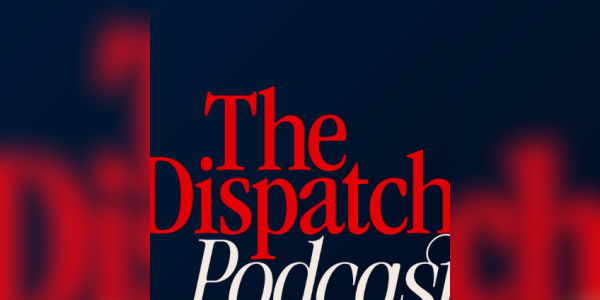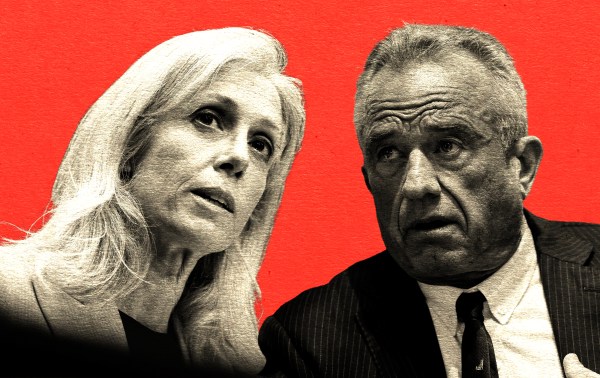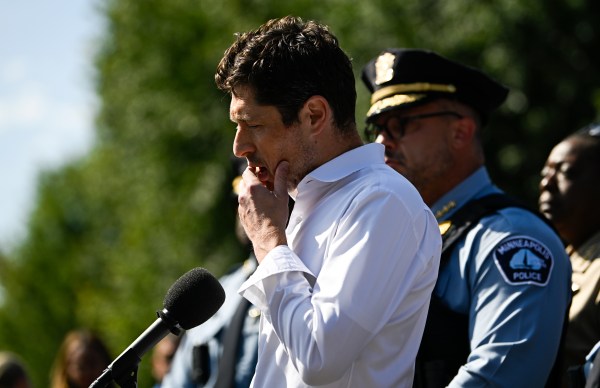I’m on mailbag duty at The Dispatch this month and spent an hour this weekend reviewing questions left for me by readers. One asked dryly whether I was familiar with the word “pleonastic.”
I was not. But I am now.
So instead of discoursing today at (great) length about the new U.S. trade deal with China, maybe I’ll just point you to a few graphs and wrap things up early. Have a look at this one, then this one. What else is there to say?
You know how it is with us pleonasts, though. There’s always something more to say.
The challenge in writing about this weekend’s economic news isn’t keeping things brief, it’s the fact that Jonah Goldberg and Kevin Williamson already diagnosed the underlying illness in recent pieces. “Don’t Call This Conservatism,” Jonah argued in a new essay today about the direction of the New Right. “Trump Is a Socialist,” Kevin declared last week, more to the point.
Again, what else is there to say? Under the leadership of a Republican president, and with the acquiescence of nearly the entire American right, the U.S. economy is increasingly being centrally planned.
A momentous question for the future of U.S. politics is whether that acquiescence reflects an earnest, durable ideological shift among Republicans or whether it’s what we might loosely describe as “a Trump thing.”
To put it another way, is right-wing central planning a matter of “anchoring” or is it more of a cargo cult?
‘Planning’ without planning.
Central planning under Trump juche rarely seems to involve much actual “planning.” Take, for instance, the president’s new executive order pegging the price the U.S. government is willing to pay for pharmaceuticals to the price of the same drugs in other countries.
Is that constitutional? Which drugs and which types of insurance will the new policy apply to? If what America pays is now based on what other countries pay, isn’t the obvious solution for drug manufacturers to hike prices abroad? If they can’t do that, will they be forced to withdraw from programs like Medicaid here at home? Will they be able to stay in business at all?
I doubt Donald Trump or his team have thoughtful answers to any of those questions, but I know for a fact that they understand the risk of unintended consequences here. What the president is attempting is a form of price controls, after all, something that he and other prominent Republicans rightly condemned during the campaign as terrible, shortage-inducing, left-wing policy when Kamala Harris proposed her own version. Less than a year later, he’s slapping a red MAGA cap on the same idea and expecting rank-and-file Republicans to salute. And most will.
Today’s new agreement with China suggests there wasn’t much planning to the trade war either, beyond “let’s dial up the tariffs and see what happens.”
Soon after being sworn in, the president raised rates on Beijing a little, then a little more after China retaliated, then a lot more on “Liberation Day,” then a lot, lot, lot more once a tit-for-tat ensued. Was the plan to decouple our economy from theirs, forcing America to rebuild its manufacturing base by thrusting the country into autarky? Or was the plan to pressure the Chinese into lowering their trade barriers to U.S. exports, resulting in freer and fairer commerce between our nations?
It was neither. There was no plan. If the plan had been to decouple, Trump and his aides wouldn’t have also hiked rates on “Liberation Day” for friendly nations that could have picked up the immediate manufacturing slack left by China. If the plan had been to encourage freer trade, the president wouldn’t have spent the past year hyping the miraculous golden age that prosperity-creating, revenue-raising tariffs would supposedly soon usher in.
I suspect the “plan” was no more elaborate than to hike tariffs, keep on hiking in response to Chinese countermeasures, and hope for the best. Once markets began to short-circuit, Trump got cold feet and started looking for a deal. But there wasn’t a plan to that either: As recently as three days ago, with Treasury Secretary Scott Bessent set to meet Chinese representatives, the closest thing the president had to a strategy was to declare on Truth Social, “80% Tariff on China seems right! Up to Scott B.”
The new tariff rate on China under the deal announced today by Scott B. is 30 percent, not 80, and it will apply only for the next 90 days while negotiations continue. (The United States is now engaged in two different 90-day “pauses” involving global trade, if you can believe it.) That’s almost identical to the 34 percent tariff originally imposed on Chinese imports on “Liberation Day,” before the tit-for-tat boosted it to 145 percent. Which means six weeks of needless economic chaos, followed by today’s big “win,” have delivered us back to square one of the trade war, neither decoupled from China nor able to trade freely with them but saddled with an onerous new tax that will make life much more expensive for everyone.
Granted, that tax is less onerous than it was 24 hours ago, but it could very well be 10 times more onerous 24 hours from now. It all depends on what “seems right” to the central planner and his advisers.
Trump’s price controls on pharmaceuticals left economist Jessica Riedl chuckling at the absurdity of right-wing populists despising progressives while slowly adopting all of their policies. “So the central planner-in-chief—who wants to decide how much lumber we import from Canada, what we pay for Chinese t-shirts, and how many pencils we buy—now wants government price controls on prescription drugs,” Riedl wrote. “Note how almost everything MAGA screamed at Democrats about—inflation, spending, deficits, regulations, price controls, airline chaos, corruption, executive power grabs, stomping dissent, ignoring courts—Trump is tripling down on. So none of their criticism was in good faith.”
Tax hikes on the rich, too. Don’t forget those.
Do socialist-hating Republican voters want their country to operate this way?
I’m not asking whether they’re willing to have it operate this way for four years in the name of loyalty to the president. The answer to that is clear. I’m asking whether they’re so enthusiastic about his agenda and the chaotic way in which it’s been implemented that they’ll expect, or even demand, the same from whoever succeeds him as leader of the GOP.
Have they been “anchored” or are they a cargo cult?
Anchoring.
“Anchoring” is another term with which I wasn’t familiar, but we all understand the concept intuitively. In the words of the New York Times, it’s “when a certain piece of information, like a high number thrown out in the course of a negotiation, can reset a whole frame of reference.”
You want a raise of 10 percent. Your boss is planning to offer you 5. You ask for 15, altering the boss’ expectations of what’s appropriate. You end up getting 10.
The president has endorsed this negotiation strategy in print. “My style of deal-making is quite simple and straightforward,” he wrote in The Art of the Deal. “I aim very high, and then I just keep pushing and pushing and pushing to get what I’m after. Sometimes I settle for less than I sought, but in most cases I still end up with what I want.”
That’s anchoring, and it works—and not just on your boss. The 80 percent rate on China that Trump floated a few days ago might have made Bessent’s offer of 30 percent feel generous, and thus more acceptable, to Chinese negotiators. Meanwhile, the S&P 500 rose more than 3 percent today on news of the deal, even though the new rate is little different from the “Liberation Day” rate that sent markets crashing in the first place.
Trump’s initial escalation with China scrambled market expectations by portending a ruinous decoupling between our two countries. Anchored to that baseline, investors are treating a “mere” 30 percent tariff as a wonderful reprieve. A headline on the online forum Free Republic this morning laughably described the new rate as a “115 percent cut,” never mind that it’s considerably higher than it was less than two months ago.
It’s easy to believe that grassroots Republicans will be “anchored” durably to all sorts of terrible nationalist impulses as their political default after Trump is gone. Every president reshapes expectations to some degree, but the revolutionary spirit of Trumpist populism and its obsession with “strength” means that any sharp retreat from his agenda by a future GOP leader will be viewed by many as weakness-driven regression to a wan, unhappy, pre-revolutionary norm.
For example, the Times reports that corporate executives have been heard to say lately that “10 percent is the new zero,” i.e., that the new global tariff rate on countries other than China is the lowest American businesses can reasonably hope for from this administration. As that becomes the new right-wing expectation for foreign imports, how comfortable would President Brian Kemp realistically be with dispensing with tariffs entirely in 2029?
He doesn’t want foreigners to “win” by facilitating completely free trade, does he?
The same logic will apply to immigration. Republican voters last year didn’t demand that foreign-born gang members be exiled to an El Salvadoran prison, but now that that’s the baseline for being tough on immigrant crime, President Kemp will be expected to show more ruthlessness in the matter than he otherwise might have. So too for foreign policy: Thanks to Trump, Republican voters are now far more likely to view the European Union, Canada, and Ukraine as “unfriendly” or “an enemy” than they were a few years ago. President Kemp will need to approach those countries more warily than he’s inclined so as not to offend parts of his base.
Even something like price controls on prescription drugs might have legs. A traditionally conservative president wouldn’t want to meddle with the market on such things, but President Kemp’s precious ideological principles will no longer excuse him from having to justify himself to the right. Trump was willing to use executive power to try to bring prices down, populists will say. Why aren’t you?
Do you think “because that’s not the way the Constitution works” will cut it as an answer?
Bear in mind, the Republican electorate is now quite different, and considerably less educated, after 10 years of Trump than it was before. It won’t just be MAGA demagogues demanding that the president they elected intervene in commercial matters to favor the working class. Blue-collar voters who were drawn to the party by Trump will expect it too. Personnel is policy, and the GOP’s “personnel” has a lot more hard hats than it used to.
Even more so than being “anchored” to the substance of a nationalist agenda, though, my guess is that the Republican base will be anchored to the authoritarian model as a mode of exerting power going forward.
Americans are quite malleable on policy and easily influenced by the preferences of their party’s leader, as we’re discovering hour by hour on the right. One can imagine President Kemp changing some populist minds on things like Canada and price controls. But now that Trump has raised the bar for, er, “energetic” executive action, I don’t know that grassroots Republicans will ever again tolerate a chieftain from their tribe declining to use power against his/their enemies for airy reasons of federalism, comity, or civic restraint. Their view of politics reflects their leader’s: All solutions to policy problems are easy if only you can muster the will to smash through the partisan and institutional resistance to them.
The right’s appetite for the socialist program might not last, but their appetite for ruthlessness will, I’d bet. Which is why the idea of “President Kemp” is almost certainly a pipe dream in the first place.
Cargo cult.
With respect to the economy, American voters tend to behave like a cargo cult.
They did last year, anyway. No matter how often and how excitedly candidate Trump promised on the trail to raise taxes on foreign goods, especially the mountains of stuff everyone buys from China, an inflation-weary electorate concluded that he was the country’s economic savior.
Like Pacific islanders during World War II, they knew that the strange man who arrived in Washington in 2017 had brought prosperity with him that improved their lives. But they couldn’t explain how or why, so they seem to have assumed that he was possessed of special powers that would magically conjure more “cargo” if he returned—no matter what his actual policies were.
Recent polling suggests some of his “softer” supporters have begun to leave that cargo cult as reality bites, but most Republicans haven’t, nor will they. That’s because some unknown but sizable quotient of Trump’s popularity on the right is plainly specific to him, not to his agenda. A future GOP leader like J.D. Vance implementing the same policies might not get the same grace from the Trump cult that the president enjoys.
“Trump is extremely unique,” former New Hampshire Gov. Chris Sununu told Politico in January. “There’s no ‘Trump lite’ or ‘Trump 2.0’ that can replace or replicate what he’s brought to the table, for better or for worse.” There’s a bit of conservative wishful thinking in that, a hint that Republicans might be set to revert to Reaganism once Trump is gone and the spell has broken, but there’s truth to it too. Trump is unique in certain ways.
He wore a celebrity halo when he entered politics. The TV show he hosted was a popular mythmaking enterprise whose premise was that he was a sort of executive genius. His program writ large is a bid to restore “American greatness” with himself in the role of national savior. He’s used every setback he’s experienced since 2015 to portray himself as a martyr persecuted by leftists for the sin of opposing them. He means to be perceived as a monarch of sorts based on everything from the scale of his power grabs to his preferences in Oval Office decor. And he did, in fact, preside over a famously prosperous economy during his first term as president before the pandemic struck. That’s not hype.
In short, he’s an authoritarian mystique machine. Having overcome two assassination attempts, two impeachments, and four criminal indictments to become the first Republican in 20 years to win the national popular vote, many right-wingers seem to see him as invincible, a superhero capable of defying political “gravity.”
The fact that he’s embarrassed them so often, in so many ways, for so many years, with new examples arriving by the hour, has worked in his favor in a way. Republican voters have sunk so much of their political capital—and dignity—into him that they have little choice but to go on defending their investment. As the saying goes: If you owe the bank $100,000, the bank owns you, but if you owe the bank $100 million, you own the bank. Trump owns the grassroots right.
All of which helps explain the otherwise idiotic spectacle of right-wing populists, including members of Congress, gloating today as markets soared on news that the president has retreated from one of his horrible policies. As a matter of ideology, that makes no sense: A nationalist who believes in decoupling from China and waging a scorched-earth trade war to repatriate jobs shouldn’t be happy to see investors incentivizing the White House to back away from protectionism.
But it makes sense to a cargo cult. The strange orange man has used his magical powers to bring us more prosperity by triggering a rally on Wall Street. Let us give thanks.
Magic can’t be second-guessed. If you’ve spent 10 years believing that Trump is some sort of demigod and then he turns around one day and says, “Let’s put price controls on drugs,” you won’t sacrifice your belief in the divine for the sake of Hayekian economic theory. But if President J.D. Vance, who’s no one’s idea of a god, were to say the same thing, the foolishness of his policy would be more apparent. He didn’t descend from the sky in 2017 bringing prosperity to the island. He doesn’t get the same benefit of the doubt.
If you’re hoping for a modest turn back towards conservatism in the post-Trump GOP, that’s your best bet. Certainly, once Trump is gone, many a right-wing coward who bit their tongue over the last decade will decide it’s finally safe to do some throat-clearing about how Russia really is bad, tariffs do more harm than good, and out-and-out bribery in broad daylight shouldn’t be condoned. Republican central planning will remain more tolerated than it was in 2015—but less than it is in 2025.
Just don’t expect too much. The shining lesson about American conservatives over the past 10 years is that they can and will talk themselves into defending anything based on the belief that the liberal alternative is necessarily worse, which might be an even easier task in 2028 than it was in 2024. We may spend the next cycle being warned ad nauseam by the right that the next election is the most important in history, even as we end up with two progressive candidates on the ballot whose agendas are broadly indistinguishable. As of today, we’re well on our way.







Please note that we at The Dispatch hold ourselves, our work, and our commenters to a higher standard than other places on the internet. We welcome comments that foster genuine debate or discussion—including comments critical of us or our work—but responses that include ad hominem attacks on fellow Dispatch members or are intended to stoke fear and anger may be moderated.
With your membership, you only have the ability to comment on The Morning Dispatch articles. Consider upgrading to join the conversation everywhere.